Get ready to fall in love with these unique and rare dog breeds you won't likely see at your local dog park—or almost anywhere else
23 Rare Dog Breeds You Probably Don’t Know About
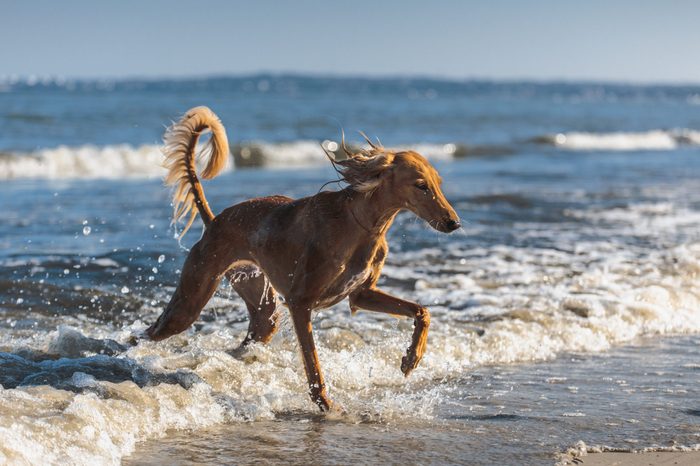
What makes these dog breeds rare?
Want a rare dog that stands paws apart from the other dogs at the dog park? Well, we have some adorable and unique dog breeds you’ll go barking mad over. Fair warning: You may have to wait before you get one, as from a huge number of dog breeds, some of these breeds may be hard to come by.
What makes these breeds rare? Simply put, it’s a numbers game. First off, certain dogs may be scarce because the intended purpose of the dog is no longer needed—for instance, dogs that were bred for herding or hunting specific animals or birds. Another reason there are rare dog breeds is that there just aren’t that many of that breed at the moment. Although some of these dogs may be more expensive breeds because of their rarity, these special dogs are every bit as lovable as the most popular dog breeds.
Get Reader’s Digest’s Read Up newsletter for more pet insights, cleaning, humor, travel, tech and fun facts all week long.
About the experts
|
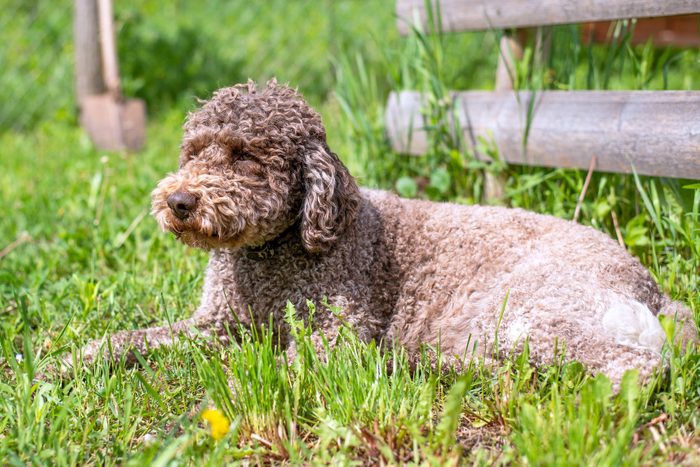
1. Lagotto Romagnolo
Curly-haired Italian dog breeds are so darn cute and cuddly, and the Lagotto Romagnolo is no exception. “Their name means ‘water dog’ in Italian, but they are commonly called ‘truffle dogs’ because they are used to hunt for truffles,” explains Catherine Lenox, DVM, the scientific affairs manager at Royal Canin. In fact, the Lagotto Romagnolo is the only purebred in the world recognized as a specialized truffle searcher. Truffle hunters or not, they are warm and friendly companions.
| Breed overview | |
| Height: | 16 to 19 inches, at the shoulder |
| Weight: | 24 to 35 pounds |
| Life expectancy: | 13 to 15 years |
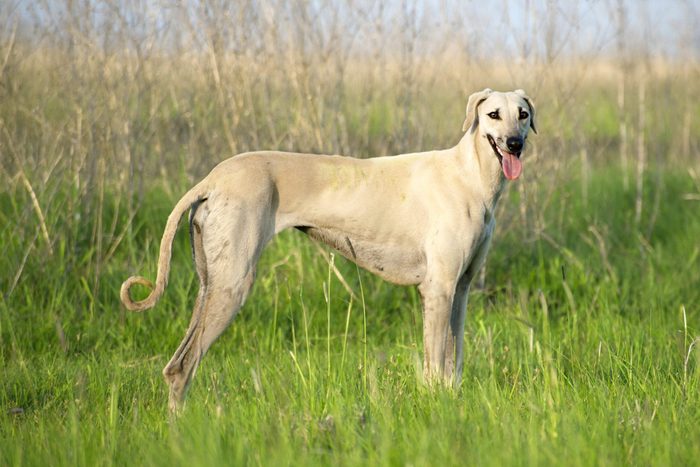
2. Sloughi
You can see why this unique dog is nicknamed the “Arabian greyhound,” as the resemblance is uncanny—and they are one of the fastest dog breeds in existence. “Originally from North Africa, where they were bred to hunt game such as gazelles, Sloughi make somewhat reserved pets and may require some extra socialization to warm up around strangers,” says Dr. Lenox.
Yet, they form a closely knit bond with their person or family. Because of their hunting genes, they might not make the best roommates with smaller animals and birds unless introduced to them at an early age.
| Breed overview | |
| Height: | 24 to 29 inches, at the shoulder |
| Weight: | 35 to 50 pounds |
| Life expectancy: | 10 to 15 years |
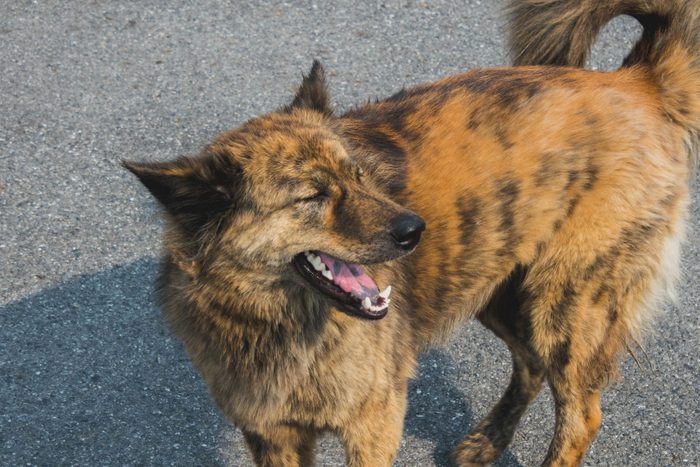
3. Kai Ken
We can’t get enough of super cute Japanese dog breeds, including the Kai Ken. Their showstopping, striking brindle coat is uniquely beautiful.
“Nicknamed ‘Tora Dog’ (tora is Japanese for ‘tiger’), this breed is athletic—the Kai Ken tends to be a good swimmer and climber,” says Dr. Lenox. They are exceptionally clever and devoted to their family. As one of the six native Japanese breeds, they are one of the rarest dogs in the world. The Kai Ken became a designated national treasure of Japan in 1934 and is protected by law.
| Breed overview | |
| Height: | 15.5 to 19.5 inches, at the shoulder |
| Weight: | 20 to 40 pounds |
| Life expectancy: | 12 to 15 years |

4. Australian kelpie
When it comes to herding sheep, the Australian kelpie is the blue-chip candidate for rounding up the herd, whether the herd consists of sheep, other dogs or kids. It’s outgoing and friendly, but also a workaholic and brainiac that requires loads of exercise and mental stimulation. For that reason, the kelpie isn’t a breed for a first-time dog parent or a family with young children, which may partly explain why it’s so rare.
| Breed overview | |
| Height: | 17 to 20 inches, at the shoulder |
| Weight: | 24 to 44 pounds |
| Life expectancy: | 10 to 13 years |
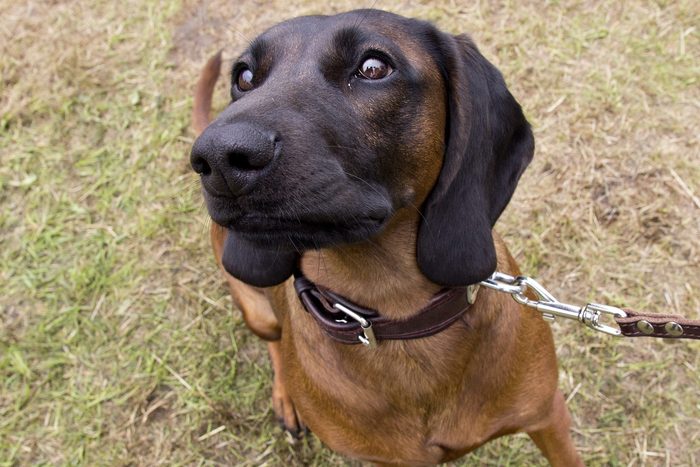
5. Bavarian mountain scent hound
The Bavarian mountain scent hound, a German breed with superior tracking ability, can differentiate between a wounded animal it is hunting and other animals of the same species. The BMSH needs lots of space to roam and expend their energy, and they’re not keen on spending time away from family in a kennel. “They are calm and devoted to their families, but they need an experienced owner,” says Mary Burch, PhD, an animal behaviorist with the American Kennel Club (AKC) Family Dog Program.
| Breed overview | |
| Height: | 17 to 20.5 inches, at the shoulder |
| Weight: | 37.5 to 55 pounds |
| Life expectancy: | 12 to 14 years |

6. Estrela mountain dog
The Estrela mountain dog is one of the oldest breeds in Portugal and one of the biggest dog breeds in the world. Rare dog breeds often make the best companions, and the Estrela is no exception.
“Much like the Leonberger, this is a big and sturdy dog with a warm personality,” says Mari-Beth O’Neill, vice president of AKC Sports Services. “You do not see dogs like this every day. If you are looking for a dog that is a protector and a playmate, this is it.”
| Breed overview | |
| Height: | 24.5 to 29 inches, at the shoulder |
| Weight: | 77 to 132 pounds |
| Life expectancy: | 10 to 14 years |

7. Thai ridgeback
It would be incredibly rare to see a Thai ridgeback outside of Thailand. You might mistake a Rhodesian ridgeback for one, as both have the trademark ridge of hair on their back that grows in the opposite direction of their coat.
Thai ridgebacks are faithful companions and exhibited their devotion to family back in the day by keeping cobras away from their humans, killing the dangerous snake if necessary. “While Thai ridgebacks can be loyal pets, they are independent and protective and are not the best choice for the first-time dog owner,” says Burch.
| Breed overview | |
| Height: | 20 to 24 inches, at the shoulder |
| Weight: | 35 to 75 pounds |
| Life expectancy: | 12 to 13 years |

8. Norwegian lundehund
The Norwegian lundehund was the one-and-only dog breed created to hunt puffins, yes, puffins. “Now that puffins are an environmentally protected species, Norwegian lundehunds have become loyal family dogs that usually have six toes on each foot instead of the usual four,” says Dr. Lenox.
They may no longer need their extra toes for scaling rocky coastlines, but the extra digits could prove useful in agility courses. Lundehunds are an easy-to-live-with breed, as long as their day is full of activities to expend their boundless energy. Almost extinct twice in their history, they are again close. Some breeders are advocating crossing to a related breed to widen their gene pool and combat some digestive issues.
| Breed overview | |
| Height: | 12 to 15 inches, at the shoulder |
| Weight: | 20 to 30 pounds |
| Life expectancy: | 12 to 15 years |

9. Bergamasco sheepdog
Of all the rare dog breeds, the “flocks” on the Bergamasco sheepdog are certainly unique, with hair that makes them look like a mop. How is that hair even natural? But it is, and it happens because the strands of hair get woven together, creating flat layers of felted hair that cover the body and legs.
Surprisingly, the flocks don’t shed and aren’t as hard to maintain as they look, O’Neill says. Bergamascos proudly take up their post as calm and watchful guardians of the family. They’re accommodating and trainable, with just a wee bit of mountain dog independence. Overall, the Bergamasco is a healthy and low-maintenance dog breed.
| Breed overview | |
| Height: | 22 to 23.5 inches, at the shoulder |
| Weight: | 57 to 84 pounds |
| Life expectancy: | 13 to 15 years |

10. Pyrenean shepherd
How about a muzzle snuggle from this cute scruffy face? The Pyrenean shepherd is a bright-eyed dog with a perpetual smile. The breed is a great candidate for agility, rally, obedience, dock diving, freestyle work and almost any fun dog sport. Devoted to their family, the Pyrenean has an intuitive sense about their owner’s desires and does particularly well with clicker training and positive, reward-based methods. They’re also one of the dog breeds that live the longest.
| Breed overview | |
| Height: | 15 to 18.5 inches (rough faced), 15.5 to 21 (smooth faced), at the shoulder |
| Weight: | 15 to 30 pounds |
| Life expectancy: | 14 to 16 years |

11. Biewer terrier
Pronounced like “beaver,” the Biewer terrier is one of the cutest little lap dog breeds you ever did see. Its sole purpose is to love and be loved. Biewers have that swoon factor of being adorably innocent when they nonchalantly pick up your slipper or their favorite toy and carry it around. They’re ever so charming and friendly, making friends with everyone they meet, including dogs they don’t know.
This unique dog breed won’t stay rare for long. It’s seeing a growing amount of interest, says Jerry Klein, DVM, chief veterinary officer of the AKC. According to the AKC, Biewers are also “the first breed to be recognized as a breed of its own (purebred) using advancements in science rather than the traditional process of pedigree documentation.”
| Breed overview | |
| Height: | 7 to 11 inches, at the shoulder |
| Weight: | 4 to 8 pounds |
| Life expectancy: | 16 years |

12. Cesky terrier
You know you’re top dog if your picture is on a postage stamp and you’re the national dog of your country. The contemplative eyes and distinguished beard of the Czech Republic’s Cesky terrier convey a stately and dignified vibe. Yet the terrier is no stuffy politician.
“They are a pack breed, which means they would fit well with other dogs, and they love to play and are great companions with their family,” says Dr. Klein. The Cesky isn’t a breed you’ll bump into at the dog park—there are only about 600 of them in the United States.
| Breed overview | |
| Height: | 10 to 13 inches, at the shoulder |
| Weight: | 14 to 24 pounds |
| Life expectancy: | 13 to 15 years |
Also, don’t miss out on these 15 adorable Wire-Haired Dog Breeds—ready to be your family’s new best friends!
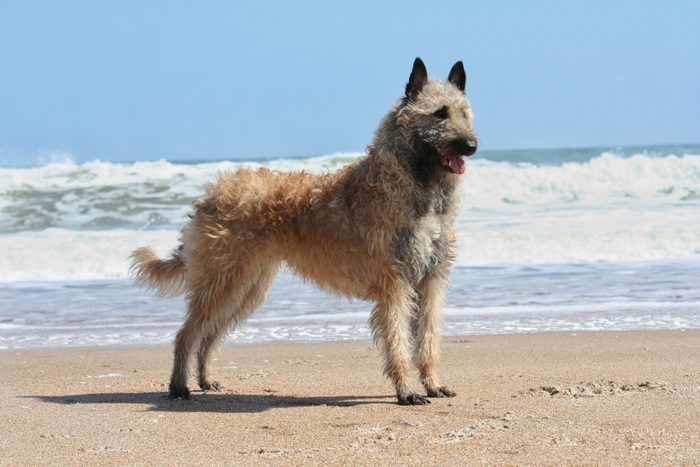
13. Belgian Laekenois
The Belgian Laekenois is the rarest of the four native Belgian shepherds (including the Belgian sheepdog, Malinois and Tervuren) in the United States. If you can get your hands on one, you’ll never want to stop snuggling its tousled coat, but the Laekenois will probably put some time limits on it. They’re no slackers and won’t be satisfied with sitting around the house or being left alone in the backyard. Laekenois want to be with their human family and require an active lifestyle to be happy.
| Breed overview | |
| Height: | 22 to 26 inches, at the shoulder |
| Weight: | 40 to 80 pounds |
| Life expectancy: | 14 to 16 years |

14. Portuguese podengo
The Portuguese podengo comes in two different sizes, and back in the day, each size had its own job. The larger one hunted deer and boar, while the medium hunted rabbits. Chasing and hunting are in their genes, so they’re wired to run and play until they drop. As far as family life goes, they hit all the high marks as warm and friendly companions that are open to friendships with new people and dogs. They have few genetics problems, so you probably won’t have to visit the vet as often.
| Breed overview | |
| Height: | 16 to 22 inches (medium), 22 to 28 (large), at the shoulder |
| Weight: | 35 to 44 pounds (medium), 44 to 66 (large) |
| Life expectancy: | 10 to 15 years |

15. Treeing Tennessee brindle
The Treeing Tennessee brindle hails from the United States, mainly in and around the Appalachian and Ozark Mountains. Noted for their brindle coat, TTBs are also alert, agile and super fast. They have an inherent instinct to hunt, and they “tree” their prey by forcing it up into a tree. Once they have the prey isolated, they alert their human by baying. According to the AKC, the old saying “You’re barking up the wrong tree” comes from this type of hunting.
For non-hunting humans, TTBs love agility training, going out for walks several times a day, playing games inside (like hide-and-seek) and chasing balls.
| Breed overview | |
| Height: | 16 to 24 inches, at the shoulder |
| Weight: | 30 to 50 pounds |
| Life expectancy: | 10 to 12 years |

16. Teddy Roosevelt terrier
The Teddy Roosevelt terrier is a lively, friendly, affectionate dog with his family but often will latch onto one person in particular. The breed was named in honor of President Teddy Roosevelt, who “appointed” these rat terriers to combat the rat infestation in the White House. Spunky and lovable, these dogs are outgoing and friendly with kids and other family pets, when raised together. With their love of social life, they don’t do well when they’re in kennels, consistently tied up or isolated from their people.
| Breed overview | |
| Height: | 8 to 15 inches, at the shoulder |
| Weight: | 8 to 25 pounds |
| Life expectancy: | 14 to 16 years |

17. Peruvian Inca Orchid
If the great outdoors makes you feel icky, then the Peruvian Inca Orchid, a hairless dog breed, could be the perfect canine BFF for you. They come in three different sizes, and their delicate, hairless bodies don’t fare well outside, so they prefer the indoors. When they do go out for walks, sunscreen is a must for their coat. One big word of warning though: PIOs are sighthounds and may see small pets as prey. As a primitive breed, their temperaments can vary from docile to more feral, so they’re not ideal for families with young children.
| Breed overview | |
| Height: | 9.75 to 25.75 inches, at the shoulder |
| Weight: | 8.5 to 55 pounds |
| Life expectancy: | 12 to 14 years |

18. Dandie Dinmont terrier
The only dog breed named for a literary character, the Dandie Dinmont terrier was named after a robust and friendly farmer in Sir Walter Scott’s 1814 book Guy Mannering. The book is much easier to find these days than the dog, however.
“There are few breeds in the United States rarer than the Dandie Dinmont terrier,” says Dr. Klein. “The breed is small but not dainty, lovable and playful but still tough, and amongst the most docile of the terriers. They would make an excellent apartment dog, but they can be hard to obtain. Should you be lucky enough to find a breeder of DDTs, you will almost certainly find your best friend in this breed.”
| Breed overview | |
| Height: | 8 to 11 inches, at the shoulder |
| Weight: | 18 to 24 pounds |
| Life expectancy: | 12 to 15 years |

19. Saluki
The Saluki’s slim and leggy appearance is naturally adept for swiftness and agility—skills they needed thousands of years ago as the favorite hunting hound of Egyptian pharaohs. In fact, they were so highly esteemed that Salukis were often mummified like the bodies of the pharaohs themselves. The only things most Salukis hunt for these days are toys and your affection, but give them a chance and they’ll chase just about anything. In fact, they’re still used in the Middle East to hunt gazelle and in the western United States to hunt jackrabbits.
| Breed overview | |
| Height: | 23 to 28 inches, at the shoulder |
| Weight: | 40 to 65 pounds |
| Life expectancy: | 10 to 14 years |

20. Azawakh
At first glance, you might think we showed you the same rare dog breed twice. “Easily confused with a Saluki, the Azawakh (pronounced AZ-uh-wahk) is unique in its own right,” says O’Neill. “Many people find them distant or aloof, but those who own the breed know how loyal and sweet they can be.”
This sighthound from Africa used to chase gazelles across the searing sands of the Sahara, but these days the Azawakh favors sidewalks over sand and fancies running with its human. While the Azawakh has been gracefully walking the earth for thousands of years, it was only recently recognized as an AKC breed in the Hound Group, in 2019.
| Breed overview | |
| Height: | 23.5 to 29 inches, at the shoulder |
| Weight: | 33 to 55 pounds |
| Life expectancy: | 12 to 15 years |

21. Canaan dog
The Canaan dog is one of the AKC’s oldest breeds and also the national dog of Israel. You might not need a security system if you have one of these guard dogs. They are vigilant and highly territorial, as well as very protective of their family. Their superior sense of smell and hearing can identify non-family members from a considerable distance.
“Canaan dogs are a sturdy breed. They need an alpha at all times, but they’re great with other animals after a good amount of training and socialization,” says O’Neill. “If you want to hike, run or play, the Canaan dog is a great fit, as they can easily keep up.”
| Breed overview | |
| Height: | 19 to 24 inches, at the shoulder |
| Weight: | 35 to 55 pounds |
| Life expectancy: | 12 to 15 years |

22. Otterhound
Looking for a dog breed that’s excited to see you when you get home yet independent enough not to make you its entire world? The rare and wonderful otterhound could be the perfect match for you—if you can find one. O’Neill says there are only about 600 in the world.
“This breed is fun and great with kids! They have a great expression and are very active,” she adds. Activities aren’t limited to dry land when you have an otterhound. Their waterproof, wire-haired coat and webbed feet come in handy on the trails or in the water. And they have a highly sensitive nose that allows them to follow a scent trail even underwater.
| Breed overview | |
| Height: | 24 to 27 inches, at the shoulder |
| Weight: | 80 to 115 pounds |
| Life expectancy: | 10 to 13 years |
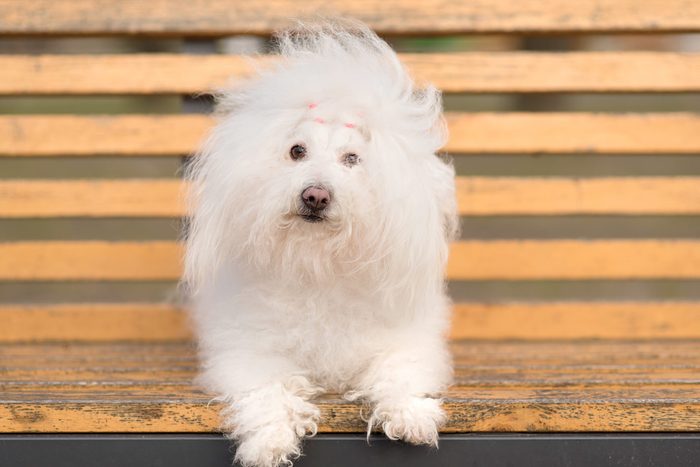
23. Bolognese
Nope, we’re not talking about the delicious Italian meat sauce—although the Bolognese breed was developed in Bologna, Italy. The Bolo, as fans call it, is a 5-to-9-pound lapdog that relishes a low-key and leisurely lifestyle, meaning that pet parents don’t have to worry about providing too much exercise. A walk or low-energy game is all this faithful and affectionate dog needs. Oh, and though it has a fluffy coat, it doesn’t shed much at all, but regular grooming is a must for the full-length cut. The “mophead” look achieved with a shorter cut is easier to maintain and equally adorable.
| Breed overview | |
| Height: | 10 to 12 inches, at the shoulder |
| Weight: | 5.5 to 9 pounds |
| Life expectancy: | 12 to 14 years |
Why trust us
At Reader’s Digest, we’re committed to producing high-quality content by writers with expertise and experience in their field in consultation with relevant, qualified experts. For this piece, Lisa Marie Conklin tapped her experience covering pet behavior and training, and then Caroline Coile, PhD, an award-winning journalist specializing in canine breeds, health and science, gave it a rigorous review to ensure that all information is accurate and offers the best possible advice to readers. We verify all facts and data, back them with credible sourcing and revisit them over time to ensure they remain accurate and up to date. Read more about our team, our contributors and our editorial policies.
Sources:
- Catherine Lenox, DVM, regulatory veterinary manager at Royal Canin; interviewed July 2021
- Mary Burch, PhD, animal behaviorist with the AKC Family Dog Program; interviewed July 2021
- Jerry Klein, DVM, chief veterinary officer of the AKC; interviewed July 2021
- Mari-Beth O’Neill, vice president of AKC Sports Services; interviewed July 2021





















